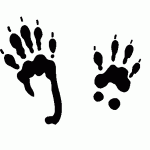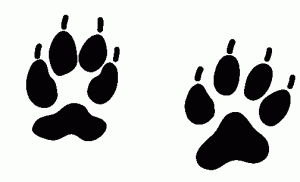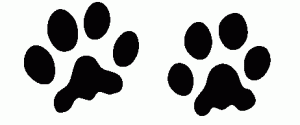January 3, 2013 at 4:17 pm
It’s that awkward time of year. Hunting for most species has ended, the lakes are not frozen enough to do some fishing yet, and folks, kids and adults alike, are fidgety sitting inside on the weekends. What is there to do that isn’t expensive or a long drive? Well, you’re lucky. You’re in Maine, and Maine is known for woods, snow, and wildlife. Mix those three things together and you get a fun afternoon outside, looking for tracks!
The best condition for identifying tracks is fresh snow, about one inch or so, or soft mud. Depending on where you are in the state, you might have one, the other, or both of these situations. Think it might be fun, but don’t know where to start? That’s okay, below are some key tracks you could find right off your back porch! Grab a coat, a ruler, some type of track ID card or field guide, and let’s go see who has been in the woods behind the house!
Perhaps one of the most common tracks you may see right in your back yard may look like this:  They are small. The front track (right) is about one and half inches long, the back track (left) is about two and a quarter inches long. This critter loves bird seed, is active all winter, and hopefully has enough seeds stored to last until spring. Squirrels are all over back yards in the winter, and kids love identifying squirrel tracks.
Here’s another one.
They are small. The front track (right) is about one and half inches long, the back track (left) is about two and a quarter inches long. This critter loves bird seed, is active all winter, and hopefully has enough seeds stored to last until spring. Squirrels are all over back yards in the winter, and kids love identifying squirrel tracks.
Here’s another one. This track is about four inches long and is often found in back yards, particularly around bird feeders. Often where there is one set, there are lots of sets. Turkeys can be found in smaller flocks in the winter in areas where there is little food to be found. But around feeders, where there is a steady supply of food, turkeys will congregate into larger flocks.
Let’s try another.
This track is about four inches long and is often found in back yards, particularly around bird feeders. Often where there is one set, there are lots of sets. Turkeys can be found in smaller flocks in the winter in areas where there is little food to be found. But around feeders, where there is a steady supply of food, turkeys will congregate into larger flocks.
Let’s try another.  Both the front and back tracks are about two and a quarter to two and a half inches long. The double lobe on the bottom of the large pad and the evidence of claws suggests the animal is a canine of some type. Cat tracks typically have three lobes on the bottom of the largest pad and no evident claw marks (as their claws are retractable). If you own a dog, or have some running around your neighborhood, these tracks can be fairly easily identified. There is no reliable way to distinguish between coyote tracks, whose average dimensions are mentioned above, and domestic dog tracks. Some domestic dog tracks may be four inches tall, but most medium to large breeds produce a track similar in size to that of a coyote. Fox tracks are very similar as well, although sometimes slightly smaller. Here’s a house cat track for comparison.
Both the front and back tracks are about two and a quarter to two and a half inches long. The double lobe on the bottom of the large pad and the evidence of claws suggests the animal is a canine of some type. Cat tracks typically have three lobes on the bottom of the largest pad and no evident claw marks (as their claws are retractable). If you own a dog, or have some running around your neighborhood, these tracks can be fairly easily identified. There is no reliable way to distinguish between coyote tracks, whose average dimensions are mentioned above, and domestic dog tracks. Some domestic dog tracks may be four inches tall, but most medium to large breeds produce a track similar in size to that of a coyote. Fox tracks are very similar as well, although sometimes slightly smaller. Here’s a house cat track for comparison. It can be a lot of fun for adults and youths to investigate who has been walking around behind the house or on the woods trail. For more tracks, pick up a track ID pocket card from any of our regional offices, or our main office in Augusta. Then grab the dog and the kids and get outside!
Remember, fresh tracks in fresh snow or mud are the best for identifying. Old tracks in snow melt out, giving the impression that the track was significantly larger than it actually was. Track details, such as presence of toe nails or number of lobes may also be lost as tracks melt out.
It can be a lot of fun for adults and youths to investigate who has been walking around behind the house or on the woods trail. For more tracks, pick up a track ID pocket card from any of our regional offices, or our main office in Augusta. Then grab the dog and the kids and get outside!
Remember, fresh tracks in fresh snow or mud are the best for identifying. Old tracks in snow melt out, giving the impression that the track was significantly larger than it actually was. Track details, such as presence of toe nails or number of lobes may also be lost as tracks melt out.
 They are small. The front track (right) is about one and half inches long, the back track (left) is about two and a quarter inches long. This critter loves bird seed, is active all winter, and hopefully has enough seeds stored to last until spring. Squirrels are all over back yards in the winter, and kids love identifying squirrel tracks.
Here’s another one.
They are small. The front track (right) is about one and half inches long, the back track (left) is about two and a quarter inches long. This critter loves bird seed, is active all winter, and hopefully has enough seeds stored to last until spring. Squirrels are all over back yards in the winter, and kids love identifying squirrel tracks.
Here’s another one. This track is about four inches long and is often found in back yards, particularly around bird feeders. Often where there is one set, there are lots of sets. Turkeys can be found in smaller flocks in the winter in areas where there is little food to be found. But around feeders, where there is a steady supply of food, turkeys will congregate into larger flocks.
Let’s try another.
This track is about four inches long and is often found in back yards, particularly around bird feeders. Often where there is one set, there are lots of sets. Turkeys can be found in smaller flocks in the winter in areas where there is little food to be found. But around feeders, where there is a steady supply of food, turkeys will congregate into larger flocks.
Let’s try another.  Both the front and back tracks are about two and a quarter to two and a half inches long. The double lobe on the bottom of the large pad and the evidence of claws suggests the animal is a canine of some type. Cat tracks typically have three lobes on the bottom of the largest pad and no evident claw marks (as their claws are retractable). If you own a dog, or have some running around your neighborhood, these tracks can be fairly easily identified. There is no reliable way to distinguish between coyote tracks, whose average dimensions are mentioned above, and domestic dog tracks. Some domestic dog tracks may be four inches tall, but most medium to large breeds produce a track similar in size to that of a coyote. Fox tracks are very similar as well, although sometimes slightly smaller. Here’s a house cat track for comparison.
Both the front and back tracks are about two and a quarter to two and a half inches long. The double lobe on the bottom of the large pad and the evidence of claws suggests the animal is a canine of some type. Cat tracks typically have three lobes on the bottom of the largest pad and no evident claw marks (as their claws are retractable). If you own a dog, or have some running around your neighborhood, these tracks can be fairly easily identified. There is no reliable way to distinguish between coyote tracks, whose average dimensions are mentioned above, and domestic dog tracks. Some domestic dog tracks may be four inches tall, but most medium to large breeds produce a track similar in size to that of a coyote. Fox tracks are very similar as well, although sometimes slightly smaller. Here’s a house cat track for comparison. It can be a lot of fun for adults and youths to investigate who has been walking around behind the house or on the woods trail. For more tracks, pick up a track ID pocket card from any of our regional offices, or our main office in Augusta. Then grab the dog and the kids and get outside!
Remember, fresh tracks in fresh snow or mud are the best for identifying. Old tracks in snow melt out, giving the impression that the track was significantly larger than it actually was. Track details, such as presence of toe nails or number of lobes may also be lost as tracks melt out.
It can be a lot of fun for adults and youths to investigate who has been walking around behind the house or on the woods trail. For more tracks, pick up a track ID pocket card from any of our regional offices, or our main office in Augusta. Then grab the dog and the kids and get outside!
Remember, fresh tracks in fresh snow or mud are the best for identifying. Old tracks in snow melt out, giving the impression that the track was significantly larger than it actually was. Track details, such as presence of toe nails or number of lobes may also be lost as tracks melt out.Categories